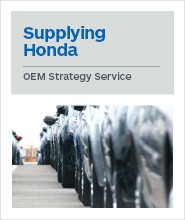
Supplying Honda
Access an OEM’s purchasing strategy, production forecasts, global footprint, supplier relations experiences, and SWOT (strength, weakness, opportunity, and threat) analysis
OEMs’ sourcing, investment, and production strategies are molded by a complex mix of interdependent factors, ranging from the outlook of local demand, trade tariffs, and supply base availability to OEMs’ technological and platform strategies. As the supply base becomes increasingly global, new opportunities are emerging for OEMs to optimize their sourcing cost structure by tapping suppliers in cost-competitive countries. In addition, the deployment of new modular vehicle platforms creates significant economies of scale for OEMs. This affects current sourcing structures, raising the risks for suppliers to win big or lose big, and even threatens the very existence of some component manufacturers.
IHS Automotive’s OEM Strategy Service provides insight, context, data, and analytics on OEM sourcing and production strategies and analysis of local supply base development in various regions and countries.
OEM strategists and planners use the service to:
- Benchmark their sourcing strategies
- Understand their sourcing potential in emerging countrie
Supplier strategists and planners use the service to:
- • Monitor the sourcing and platform outlook of their current customers
- • Decipher key sourcing patterns and strategies of new ones
About Supplying Honda
In October 1946, Soichiro Honda established the Honda Technical Research Institute in Hamamatsu, Japan, to develop and produce two-stroke motorcycle engines. Two years later, Honda Motor Company Limited (or simply Honda) was formed. Since then, Honda has developed into a multi-national company which is split into four major business sectors: automobile, motorcycle, power products (including marine and home) and financial services. In support of these sectors, Honda is now the world’s largest manufacturer of internal combustion engines. The largest of these business sectors is automotive, which contributed 78% of net sales for fiscal year ending March 31, 2013.
Honda prides itself on its engineering prowess and the company has played a pivotal role in the development of various technology innovations, covering vehicle body and powertrain and extending through to assembly activities. Powertrain innovations are largely grouped under the ‘Earth Dreams’ brand. These technologies are largely related to improved fuel economy and reduced vehicle engine emissions, which applies across all powertrains, including petrol, diesel and petrol-electric hybrids. In February 2014, Honda announced that it would look to further expand its current range of hybrid vehicles sold in North America, a key market for the company as, based on 2013 figures, the region delivered 38% of total global Honda sales.
Overview
Global light vehicle sales
Financial data
Financial overview
Product strategy
Company history and strategy review
Major model programmes
Honda - Top 10 best-selling models
CR-V
Civic
Accord
Fit/Jazz
N BOX
Odyssey
City
Pilot
N ONE
Vehicle platforms
Platform strategy
Honda - Top 10 most used platforms
C-5
GSP
D-5
N
BM/MD
GSP(2)
BM/MD(2)
2YA
2SA
NE/IN/CO/UA
Component sharing
Volume planning
Production strategy
Production strategy overview
Honda - Top 10 production plants
Japan
United States
China
Mexico
India
United Kingdom
Canada
Brazil & Argentina
Thailand
Internal supply network
Modularisation strategy
Supplier parks
Cluster of reference
Strategies for manufacturing efficiency
Purchasing strategy
Purchasing strategy overview
Levels of vertical integration and outsourcing
Purchasing organisation
Purchasing offices
Key purchasing personnel
Purchasing budget
Supplier selection
Supply base development
Major and strategic suppliers
Supplier evaluation criteria
Working with Honda Motor
Global sourcing
Policy and plans
APAC
NAFTA
EMEA
LATAM
Pricing policy
Cost reduction strategies
Payment terms
Raw material price management
Quality management
Quality level
Quality management systems
Supplier integration into product development
Management of suppliers and sub-suppliers
Supplier awards
Technology
Technological positioning
Areas of focus
R&D organisation
R&D spending
Access to supplier technology
Approach to alternative fuels, electrification and fuel cells
Special vehicle development
Forward model programmes
Interviews
Tom Lake, Honda
Rahul Misra, HARMAN
Supplier Relationship survey
Introduction to the SuRe index
Methodology
Executive summary
2014 SuRe survey results
Profit potential
Organization
Trust
Pursuit of excellence
Outlook
SuRe by region
SuRe by company size
SWOT analysis
SWOT analysis - Honda Motor
Global footprint - Honda Motor
Major suppliers (by vehicle programme, model year)
2017 Honda NSX
2016 Honda Ridgeline
2016 Honda CR-V
2015 Honda Vezel
2015 Honda Pilot
2014 Honda Fit





